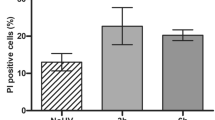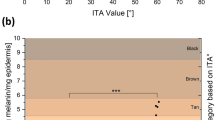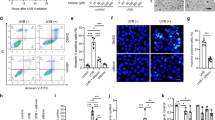Abstract
Xeroderma pigmentosum type C (XPC) is a rare autosomal recessive disorder that occurs due to inactivation of the XPC protein, an important DNA damage recognition protein involved in DNA nucleotide excision repair (NER). This defect, which prevents removal of a wide array of direct and indirect DNA lesions, is associated with a decrease in catalase activity. To test the hypothesis of a novel photoprotective approach, we irradiated epidermis reconstructed with XPC human keratinocytes sustainably overexpressing lentivirus-mediated catalase enzyme. Following UVB irradiation, there was a marked decrease in sunburn cell formation, caspase-3 activation and p53 accumulation in human XPC-reconstructed epidermis overexpressing catalase. Moreover, XPC-reconstructed epidermis was more resistant to UVB-induced apoptosis than normal reconstructed epidermis. While not correcting the gene defect, indirect gene therapy using antioxidant enzymes may be of help in limiting photosensitivity in XPC and probably in other monogenic/polygenic photosensitive disorders characterized by ROS accumulation.
This is a preview of subscription content, access via your institution
Access options
Subscribe to this journal
Receive 12 print issues and online access
$259.00 per year
only $21.58 per issue
Buy this article
- Purchase on Springer Link
- Instant access to full article PDF
Prices may be subject to local taxes which are calculated during checkout






Similar content being viewed by others
Abbreviations
- CAT:
-
catalase
- CPD:
-
cyclobutane pyrimidine dimer
- GGR:
-
global genome repair
- NER:
-
nucleotide excision repair
- nIr:
-
non-irradiated
- NT:
-
non-transduced
- RE:
-
normal reconstructed epidermis
- SBC:
-
sunburn cell
- TCR:
-
transcription-coupled repair
- XP:
-
xeroderma pigmentosum
- XP-RE:
-
epidermis reconstructed with XPC keratinocytes
References
Bootsma D, Kraemer KH, Cleaver JE, Hoeijmakers JHJ . Nucleotide excision repair syndromes: xeroderma pigmentosum, Cockayne syndrome and trichothiodystrophy. In: Scriver CR, Beaudet AL, Sly WS, Valle D (eds). The Metabolic and Molecular Bases of Inherited Disease, vol. 1. McGraw-Hill: New York, 2001, pp 677–704.
van Steeg H, Kraemer KH . Xeroderma pigmentosum and the role of UV-induced DNA damage in skin cancer. Mol Med Today 1999; 5: 86–94.
Cleaver JE, Thompson LH, Richardson AS, States JC . A summary of mutations in the UV-sensitive disorders: xeroderma pigmentosum, Cockayne syndrome, and trichothiodystrophy. Hum Mutat 1999; 14: 9–22.
Stary A, Sarasin A . The genetics of the hereditary xeroderma pigmentosum syndrome. Biochimie 2002; 84: 49–60.
de Laat WL, Jaspers NG, Hoeijmakers JH . Molecular mechanism of nucleotide excision repair. Genes Dev 1999; 13: 768–785.
Hanawalt PC . Subpathways of nucleotide excision repair and their regulation. Oncogene 2002; 21: 8949–8956.
Emmert S, Kobayashi N, Khan SG, Kraemer KH . The xeroderma pigmentosum group C gene leads to selective repair of cyclobutane pyrimidine dimers rather than 6–4 photoproducts. Proc Natl Acad Sci USA 2000; 97: 2151–2156.
Zhou NY, Bates SE, Bouziane M, Stary A, Sarasin A, O'Connor TR . Efficient repair of cyclobutane pyrimidine dimers at mutational hot spots is restored in complemented xeroderma pigmentosum group C and trichothiodystrophy/xeroderma pigmentosum group D cells. J Mol Biol 2003; 332: 337–351.
Campbell RM, DiGiovanna JJ . Skin cancer chemoprevention with systemic retinoids: an adjunct in the management of selected high-risk patients. Dermatol Ther 2006; 19: 306–314.
Atabay K, Celebi C, Cenetoglu S, Baran NK, Kiymaz Z . Facial resurfacing in xeroderma pigmentosum with monoblock full-thickness skin graft. Plast Reconstr Surg 1991; 87: 1121–1125.
Kraemer KH, DiGiovanna JJ, Peck GL . Chemoprevention of skin cancer in xeroderma pigmentosum. J Dermatol 1992; 19: 715–718.
Yarosh D, Klein J, O'Connor A, Hawk J, Rafal E, Wolf P . Effect of topically applied T4 endonuclease V in liposomes on skin cancer in xeroderma pigmentosum: a randomised study. Xeroderma pigmentosum study group. Lancet 2001; 357: 926–929.
Bernerd F, Asselineau D, Frechet M, Sarasin A, Magnaldo T . Reconstruction of DNA repair-deficient xeroderma pigmentosum skin in vitro: a model to study hypersensitivity to UV light. Photochem Photobiol 2005; 81: 19–24.
Marchetto MC, Correa RG, Menck CF, Muotri AR . Functional lentiviral vectors for xeroderma pigmentosum gene therapy. J Biotechnol 2006; 126: 424–430.
Zeng L, Quilliet X, Chevallier-Lagente O, Eveno E, Sarasin A, Mezzina M . Retrovirus-mediated gene transfer corrects DNA repair defect of xeroderma pigmentosum cells of complementation groups A, B and C. Gene Ther 1997; 4: 1077–1084.
Cadet J, Anselmino C, Douki T, Voituriez L . Photochemistry of nucleic acids in cells. J Photochem Photobiol B 1992; 15: 277–298.
de Gruijl FR, van Kranen HJ, Mullenders LH . UV-induced DNA damage, repair, mutations and oncogenic pathways in skin cancer. J Photochem Photobiol B 2001; 63: 19–27.
Doetsch PW, Zasatawny TH, Martin AM, Dizdaroglu M . Monomeric base damage products from adenine, guanine, and thymine induced by exposure of DNA to ultraviolet radiation. Biochemistry 1995; 34: 737–742.
Mitchell DL, Jen J, Cleaver JE . Relative induction of cyclobutane dimers and cytosine photohydrates in DNA irradiated in vitro and in vivo with ultraviolet-C and ultraviolet-B light. Photochem Photobiol 1991; 54: 741–746.
Ravanat JL, Douki T, Cadet J . Direct and indirect effects of UV radiation on DNA and its components. J Photochem Photobiol B 2001; 63: 88–102.
Pelle E, Huang X, Mammone T, Marenus K, Maes D, Frenkel K . Ultraviolet-B-induced oxidative DNA base damage in primary normal human epidermal keratinocytes and inhibition by a hydroxyl radical scavenger. J Invest Dermatol 2003; 121: 177–183.
Rezvani HR, Cario-Andre M, Pain C, Ged C, deVerneuil H, Taieb A . Protection of normal human reconstructed epidermis from UV by catalase overexpression. Cancer Gene Ther 2007; 14: 174–186.
Rezvani HR, Dedieu S, North S, Belloc F, Rossignol R, Letellier T et al. Hypoxia-inducible factor-1alpha, a key factor in the keratinocyte response to UVB exposure. J Biol Chem 2007; 282: 16413–16422.
Rezvani HR, Mazurier F, Cario-Andre M, Pain C, Ged C, Taieb A et al. Protective effects of catalase overexpression on UVB-induced apoptosis in normal human keratinocytes. J Biol Chem 2006; 281: 17999–18007.
Punnonen K, Puntala A, Ahotupa M . Effects of ultraviolet A and B irradiation on lipid peroxidation and activity of the antioxidant enzymes in keratinocytes in culture. Photodermatol Photoimmunol Photomed 1991; 8: 3–6.
Shindo Y, Witt E, Han D, Tzeng B, Aziz T, Nguyen L et al. Recovery of antioxidants and reduction in lipid hydroperoxides in murine epidermis and dermis after acute ultraviolet radiation exposure. Photodermatol Photoimmunol Photomed 1994; 10: 183–191.
Zhang X, Rosenstein BS, Wang Y, Lebwohl M, Wei H . Identification of possible reactive oxygen species involved in ultraviolet radiation-induced oxidative DNA damage. Free Radic Biol Med 1997; 23: 980–985.
Vuillaume M, Calvayrac R, Best-Belpomme M, Tarroux P, Hubert M, Decroix Y et al. Deficiency in the catalase activity of xeroderma pigmentosum cell and simian virus 40-transformed human cell extracts. Cancer Res 1986; 46: 538–544.
Vuillaume M, Daya-Grosjean L, Vincens P, Pennetier JL, Tarroux P, Baret A et al. Striking differences in cellular catalase activity between two DNA repair-deficient diseases: xeroderma pigmentosum and trichothiodystrophy. Carcinogenesis 1992; 13: 321–328.
Prunieras M, Regnier M, Schlotterer M . New procedure for culturing human epidermal cells on allogenic or xenogenic skin: preparation of recombined grafts. Ann Chir Plast 1979; 24: 357–362.
Khan SG, Muniz-Medina V, Shahlavi T, Baker CC, Inui H, Ueda T et al. The human XPC DNA repair gene: arrangement, splice site information content and influence of a single nucleotide polymorphism in a splice acceptor site on alternative splicing and function. Nucleic Acids Res 2002; 30: 3624–3631.
Chavanne F, Broughton BC, Pietra D, Nardo T, Browitt A, Lehmann AR et al. Mutations in the XPC gene in families with xeroderma pigmentosum and consequences at the cell, protein, and transcript levels. Cancer Res 2000; 60: 1974–1982.
Khan SG, Oh KS, Shahlavi T, Ueda T, Busch DB, Inui H et al. Reduced XPC DNA repair gene mRNA levels in clinically normal parents of xeroderma pigmentosum patients. Carcinogenesis 2006; 27: 84–94.
Li L, Bales ES, Peterson CA, Legerski RJ . Characterization of molecular defects in xeroderma pigmentosum group C. Nat Genet 1993; 5: 413–417.
Culbertson MR . RNA surveillance. Unforeseen consequences for gene expression, inherited genetic disorders and cancer. Trends Genet 1999; 15: 74–80.
Bernerd F, Asselineau D, Vioux C, Chevallier-Lagente O, Bouadjar B, Sarasin A et al. Clues to epidermal cancer proneness revealed by reconstruction of DNA repair-deficient xeroderma pigmentosum skin in vitro. Proc Natl Acad Sci USA 2001; 98: 7817–7822.
Hoffschir F, Daya-Grosjean L, Petit PX, Nocentini S, Dutrillaux B, Sarasin A et al. Low catalase activity in xeroderma pigmentosum fibroblasts and SV40-transformed human cell lines is directly related to decreased intracellular levels of the cofactor, NADPH. Free Radic Biol Med 1998; 24: 809–816.
Clement V, Dunand-Sauthier I, Clarkson SG . Suppression of UV-induced apoptosis by the human DNA repair protein XPG. Cell Death Differ 2006; 13: 478–488.
D'Errico M, Teson M, Calcagnile A, Nardo T, De Luca N, Lazzari C et al. Differential role of transcription-coupled repair in UVB-induced response of human fibroblasts and keratinocytes. Cancer Res 2005; 65: 432–438.
Ananthaswamy HN, Ouhtit A, Evans RL, Gorny A, Khaskina P, Sands AT et al. Persistence of p53 mutations and resistance of keratinocytes to apoptosis are associated with the increased susceptibility of mice lacking the XPC gene to UV carcinogenesis. Oncogene 1999; 18: 7395–7398.
Wang G, Chuang L, Zhang X, Colton S, Dombkowski A, Reiners J et al. The initiative role of XPC protein in cisplatin DNA damaging treatment-mediated cell cycle regulation. Nucleic Acids Res 2004; 32: 2231–2240.
Cario-Andre M, Briganti S, Picardo M, Nikaido O, de Verneuil H, Taieb A . Polyunsaturated fatty acids partially reproduce the role of melanocytes in the epidermal melanin unit. Exp Dermatol 2005; 14: 194–201.
Cario-Andre M, Briganti S, Picardo M, Nikaido O, Gall Y, Ginestar J et al. Epidermal reconstructs: a new tool to study topical and systemic photoprotective molecules. J Photochem Photobiol B 2002; 68: 79–87.
D'Errico M, Parlanti E, Teson M, de Jesus BM, Degan P, Calcagnile A et al. New functions of XPC in the protection of human skin cells from oxidative damage. EMBO J 2006; 25: 4305–4315.
Achanta G, Huang P . Role of p53 in sensing oxidative DNA damage in response to reactive oxygen species-generating agents. Cancer Res 2004; 64: 6233–6239.
Giaccia AJ, Kastan MB . The complexity of p53 modulation: emerging patterns from divergent signals. Genes Dev 1998; 12: 2973–2983.
Shieh SY, Ikeda M, Taya Y, Prives C . DNA damage-induced phosphorylation of p53 alleviates inhibition by MDM2. Cell 1997; 91: 325–334.
Bernerd F, Sarasin A, Magnaldo T . Galectin-7 overexpression is associated with the apoptotic process in UVB-induced sunburn keratinocytes. Proc Natl Acad Sci USA 1999; 96: 11329–11334.
Ko LJ, Prives C . p53: puzzle and paradigm. Genes Dev 1996; 10: 1054–1072.
Levine AJ . p53, the cellular gatekeeper for growth and division. Cell 1997; 88: 323–331.
Casoli V, Cario-Andre M, Costet P, Pain C, Taieb A . Comparison of long-term survival of pigmented epidermal reconstructs cultured in vitro vs xenografted on nude mice. Pigment Cell Res 2004; 17: 87–92.
Acknowledgements
We thank Mrs Catherine Pain for her help with cell culture techniques. HRR was granted by Ministry of Science, Research and Technology of Iran.
Author information
Authors and Affiliations
Corresponding author
Additional information
Supplementary Information accompanies the paper on Cancer Gene Therapy website (http://www.nature.com/cgt)
Rights and permissions
About this article
Cite this article
Rezvani, H., Ged, C., Bouadjar, B. et al. Catalase overexpression reduces UVB-induced apoptosis in a human xeroderma pigmentosum reconstructed epidermis. Cancer Gene Ther 15, 241–251 (2008). https://doi.org/10.1038/sj.cgt.7701102
Received:
Revised:
Accepted:
Published:
Issue Date:
DOI: https://doi.org/10.1038/sj.cgt.7701102
Keywords
This article is cited by
-
Effects of UVB Radiation on the Physicochemical Properties of Fibroblasts and Keratinocytes
The Journal of Membrane Biology (2016)
-
Oxidative and Energy Metabolism as Potential Clues for Clinical Heterogeneity in Nucleotide Excision Repair Disorders
Journal of Investigative Dermatology (2015)
-
c.1643_1644delTG XPC mutation is more frequent in Moroccan patients with xeroderma pigmentosum
Archives of Dermatological Research (2013)
-
Antioxidant proteins and reactive oxygen species are decreased in a murine epidermal side population with stem cell-like characteristics
Histochemistry and Cell Biology (2011)
-
A Prevalent Mutation with Founder Effect in Xeroderma Pigmentosum Group C from North Africa
Journal of Investigative Dermatology (2010)



